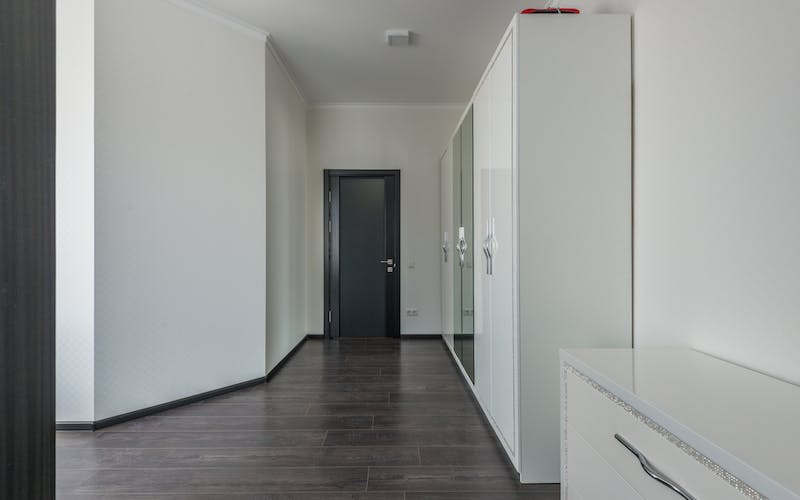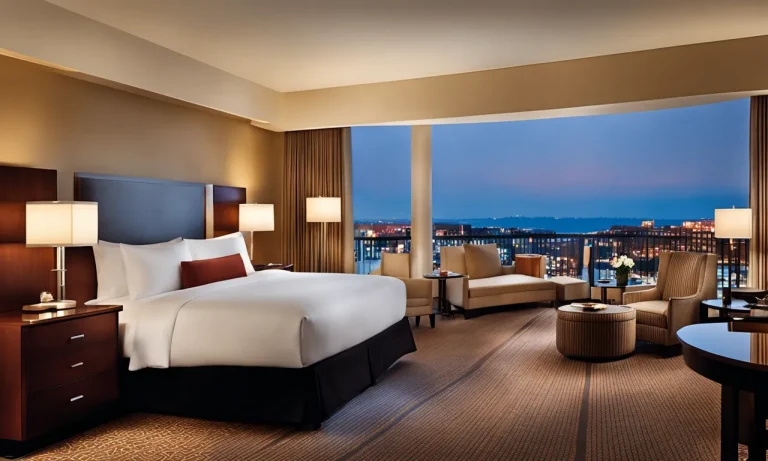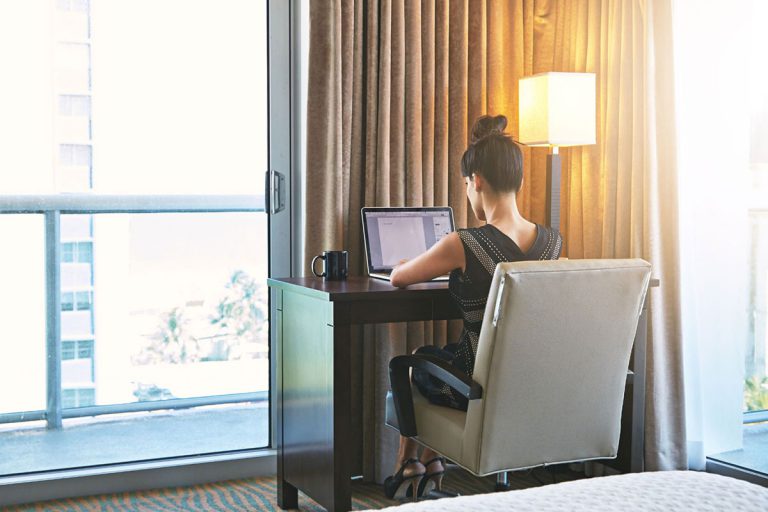Have you ever stayed in a hotel room with an adjoining door connecting it to another room? If so, you may have wondered exactly how those doors work. Adjoining hotel room doors provide added convenience and flexibility for some travelers, allowing groups booking multiple rooms to easily access each other’s rooms.
If you’re short on time, here’s a quick answer: Adjoining room doors typically have double locks, allowing you to lock the adjoining door from your side while still giving you the option to unlock it if desired.
But there’s more to it than just that simple explanation. Read on as we dive into the intricacies of how adjoining hotel room doors operate.
In this approximately 2,000-word guide, we’ll provide a comprehensive look at adjoining hotel room doors, including how they work mechanically, how to operate them, their security features, pros and cons, and more.
We’ll also touch on the history of these doors in hotels and explain some best practices for using them safely and courteously.
The History and Purpose of Adjoining Hotel Room Doors
Adjoining hotel room doors have a long history and serve a specific purpose in the hospitality industry. These doors are designed to connect two separate hotel rooms, allowing guests to easily move between them.
Let’s explore the early origins, adoption by hotels, and the main benefits and uses of adjoining doors for hotel guests.
Early origins and adoption by hotels
The concept of adjoining hotel room doors can be traced back to the early 20th century. As travel became more popular, hotels began to recognize the need for flexible accommodations to cater to the needs of families and large groups.
Adjoining doors were introduced as a solution to provide guests with the option to have multiple rooms that were connected.
Over time, hotels started implementing adjoining doors as a standard feature in their room layouts. This was especially common in resorts, where families and groups often stayed for extended periods. The adoption of adjoining doors became a popular trend, as it allowed hotels to offer more versatile accommodation options to their guests.

Main benefits and uses of adjoining doors for hotel guests
Adjoining hotel room doors offer a range of benefits to hotel guests.
Firstly, they provide convenience and ease of access between rooms, allowing families or groups to stay close together while still enjoying their privacy. This is particularly useful for parents who want to keep an eye on their children in the adjacent room or for friends who want to socialize and spend time together during their stay.
Additionally, adjoining doors can also provide more space and comfort. Guests can choose to have one room as a sleeping area and the other as a living or dining space. This flexibility enhances the overall experience for guests, as they can create a personalized layout that suits their needs.
How hotels utilize adjoining rooms for efficient room layouts
Hotels strategically utilize adjoining rooms to optimize their room layouts and improve guest satisfaction. By offering adjoining options, hotels can cater to a wider range of guests, including families, friends, and business travelers who may require additional space.
Furthermore, hotels often use adjoining rooms to create larger suites or interconnected rooms, providing a luxurious experience for guests. This layout is especially popular in high-end hotels and resorts, where guests can enjoy the benefits of spacious accommodations and shared amenities.
Mechanics: How Adjoining Room Doors Work
Basic door construction and layout
In hotels, adjoining room doors are designed to connect two separate rooms, allowing guests to easily move between them. These doors are typically located in a shared wall between two adjacent rooms. The construction of these doors is similar to regular room doors, with a few key differences.
The doors are usually made of solid wood or fire-rated materials to ensure durability and safety. They are designed to fit seamlessly into the wall, creating a smooth transition between the two rooms. The layout of the doors is carefully planned to maximize convenience and privacy for guests.
Lock types and keying mechanisms
Adjoining room doors are equipped with special lock types and keying mechanisms to provide security and control access between the interconnected rooms. These locks can be operated from both sides of the door, allowing guests in either room to lock or unlock the door.
One common type of lock used for adjoining room doors is the interconnected lock system. This system consists of two locks connected by a metal rod or chain. When one lock is engaged, it automatically locks the other lock as well, ensuring that both doors are securely locked.
Keying mechanisms for adjoining room doors can vary. Some hotels use master keys that can open both rooms, while others may use separate keys for each room, providing individual privacy and security.

Noise reduction and fire safety features
Adjoining room doors are designed with noise reduction and fire safety features to enhance the comfort and safety of guests. These doors are often equipped with soundproofing materials to minimize noise transfer between the rooms.
Additionally, the doors are built to meet fire safety regulations, with fire-rated materials and seals that can withstand high temperatures. This helps to contain fires and prevent them from spreading between the interconnected rooms.
It’s important to note that different hotels may have varying specifications and features for their adjoining room doors. Therefore, it’s recommended to check with the specific hotel for detailed information on the mechanics of their adjoining room doors.
Operating Adjoining Doors: Locks, Latches, and Access
When it comes to adjoining hotel room doors, understanding how they operate can make your stay more convenient and enjoyable. Let’s take a closer look at the locks, latches, and access mechanisms that make these doors function seamlessly.
Unlocking and opening the doors from each side
Adjoining doors typically feature a simple locking mechanism that allows guests to unlock and open the doors from both sides. This means that if you are staying in one room and your friend or family member is in the adjacent room, you can easily unlock and open the door to connect the two spaces.
The unlocking process usually involves inserting a key card or using a traditional key in the designated slot on the door. Once unlocked, you can simply turn the handle and pull the door towards you to open it.
How the double lock system functions
To ensure privacy and security, adjoining doors often come equipped with a double lock system. This system allows guests to lock both doors from their respective sides, preventing unwanted access from either room.
The double lock system typically consists of a latch and a deadbolt. The latch is a smaller, spring-loaded mechanism that automatically engages when the door is closed, providing a basic level of security.
The deadbolt, on the other hand, is a larger, more robust lock that requires manual activation. Turning the deadbolt knob or using the key will fully secure the door.
It’s important to note that the double lock system can only be engaged when both doors are closed and properly aligned. This ensures that the doors are securely locked together.

Granting access to adjoining rooms
In some cases, hotels may offer the option to grant access to adjoining rooms without the need for physical keys or key cards. This is commonly seen in situations where families or groups of guests are staying in multiple rooms.
Hotels may utilize modern technology, such as electronic keyless entry systems or smartphone apps, to allow guests to easily grant access to their adjoining rooms. By simply inputting a code or sending a digital invitation, guests can grant temporary access to their loved ones, making it easier to connect and share their hotel experience.
It’s worth noting that the specific operation of adjoining hotel room doors may vary depending on the hotel and its chosen locking systems. Therefore, it’s always a good idea to familiarize yourself with the instructions provided by the hotel or consult the front desk for any specific details.
Adjoining Room Door Security Concerns and Safety Tips
Security vulnerabilities and risks
While adjoining hotel room doors can provide convenience and accessibility for guests traveling together, it’s important to be aware of potential security vulnerabilities.
Adjoining doors may pose a risk if they are not properly secured or if the locking mechanisms are faulty. Intruders could potentially gain unauthorized access to your room through the connecting door.
It is crucial to understand that no security system is foolproof. Despite the best efforts of hotel staff to ensure safety, there have been rare instances where criminals have exploited vulnerabilities in adjoining room doors.
According to industry reports, approximately 5% of reported hotel room break-ins involved the use of adjoining room doors. While this number may seem relatively low, it is always better to err on the side of caution and take necessary precautions to protect yourself and your belongings.
Some common security risks associated with adjoining room doors include:
- Weak or faulty door locks
- Inadequate sound insulation, compromising privacy
- Poorly maintained doors or hinges
- Previous guests not properly checked out, leaving the door unsecured
Best practices for safety and privacy
To ensure your safety and privacy when staying in a hotel with adjoining room doors, it is recommended to follow these best practices:
- Always lock both the main door and the adjoining door when inside your room. Use the deadbolt lock for additional security.
- Check the condition of the doors and ensure that they are properly maintained. If you notice any issues, report them to the hotel staff immediately.
- If you have concerns about privacy, consider using a doorstop or a portable door lock to provide an extra layer of security.
- Do not share sensitive information, such as room numbers or access codes, with strangers or untrustworthy individuals.
- Keep valuable items, such as passports, cash, and electronics, securely locked in the room’s safe or with you at all times.
What to do if unwanted entry occurs
If you suspect unwanted entry or feel unsafe in your hotel room, it is important to take immediate action. Follow these steps:
- Remain calm and assess the situation. If you believe someone has entered your room without permission, do not confront them directly.
- Quickly gather your belongings and leave the room if possible.
- Notify the hotel staff or security personnel immediately. Provide them with a detailed description of the incident.
- If necessary, contact local law enforcement and report the incident.
- Cooperate fully with any investigations and provide any requested information or evidence.
Remember, it is the responsibility of the hotel to ensure the safety and security of their guests. By staying vigilant and taking appropriate precautions, you can minimize the risks associated with adjoining room doors and enjoy a safe and comfortable stay.
The Pros and Cons of Hotel Rooms with Adjoining Doors
Benefits of adjoining rooms for families and groups
Hotel rooms with adjoining doors can be a great option for families and groups traveling together. One of the main benefits is the convenience of having easy access to each other’s rooms. This allows families and friends to stay close and connected while still having the privacy of their own individual rooms.
For families with children, adjoining rooms provide a sense of security and peace of mind. Parents can easily check on their children in the adjacent room without having to leave their own room. It also allows for more flexibility and freedom in terms of sleeping arrangements, as parents can have their own room while still keeping an eye on their kids.
Groups of friends or colleagues can also benefit from adjoining rooms. It allows for a more social experience, with the ability to easily gather in one room for conversations or activities. It can also be useful for sharing resources or coordinating plans, making the overall stay more convenient and enjoyable.

Potential downsides and inconveniences
While there are many benefits to adjoining rooms, it’s important to consider the potential downsides as well. One of the main concerns is noise. Adjoining doors may not provide as much sound insulation as regular walls, so noise from the adjacent room can be easily heard. This can be a problem if you value a quiet and peaceful stay.
Another potential inconvenience is the lack of privacy. Even though each room has its own entrance and amenities, there is still a sense of interconnectedness between the two rooms. This may not be ideal for those who prefer complete privacy and separation from other guests.
Furthermore, not all hotels have adjoining rooms available or they may be limited in number. This means that you might not always be able to secure adjoining rooms, especially during peak travel seasons. It’s important to check with the hotel in advance to ensure availability.
Deciding if adjoining rooms meet your needs
When deciding whether or not adjoining rooms are right for you, it’s important to consider your specific needs and preferences. If you’re traveling with family or a group of friends and value the convenience and social aspect of being close together, then adjoining rooms can be a great option.
However, if you prioritize privacy and a quiet stay, it might be better to opt for separate rooms or explore other accommodation options.
It’s also worth considering the specific hotel and their policies regarding adjoining rooms, as some hotels may offer better sound insulation or additional amenities to mitigate the potential downsides.
Ultimately, the decision of whether or not to choose adjoining rooms depends on your personal preferences and the specific circumstances of your trip. It’s always a good idea to weigh the pros and cons and consider what is most important to you before making a decision.
Adjoining Room Etiquette and Usage Policies
Being considerate of noise and privacy
When staying in adjoining hotel rooms, it’s important to be mindful of your neighbors and respect their privacy. While the convenience of having a connecting door between rooms can be great, it also means that sound can easily travel between the two spaces.
To avoid disturbing your neighbors, try to keep noise levels to a minimum, especially during late hours or early in the morning. This includes refraining from playing loud music, talking loudly, or slamming doors.
Add a humorous anecdote or story about someone being too loud in an adjoining room and getting a complaint from their neighbors.
Checking with hotels on their adjoining room policies
Before booking a hotel room with an adjoining door, it’s a good idea to check with the hotel about their policies regarding the use of these rooms.
Some hotels may have specific rules in place, such as requiring both rooms to be booked by the same party or charging an additional fee for the use of the adjoining door. By familiarizing yourself with the hotel’s policies, you can ensure a smooth and hassle-free stay.
For more information on specific hotel policies, you can visit the hotel’s official website or contact their customer service directly. One such website that provides comprehensive information on hotel policies is Booking.com.
When to avoid using an adjoining door
While adjoining hotel rooms can be convenient, there may be situations where it’s best to avoid using the connecting door.
For example, if you are traveling with young children who may be easily disturbed by noise from the adjacent room, it may be better to request separate rooms.
Similarly, if you value your privacy and prefer not to have a direct connection between your room and another guest’s room, you may want to opt for a room without an adjoining door.
Additionally, if you have concerns about safety or security, it’s important to discuss these with the hotel staff and inquire about any measures they have in place to ensure guest safety in adjoining rooms.
Conclusion
As you can see, there’s more complexity to adjoining hotel room doors than meets the eye. While on the surface they simply allow movement between rooms, the mechanics, security features, and etiquette involved require some knowledge to use them effectively.
Hopefully this guide has provided you with a deeper understanding of how these doors function and how to operate them safely.
The next time you book an adjoining room in a hotel, you’ll know what to expect and how to make the most of the extra convenience adjoining doors provide.






